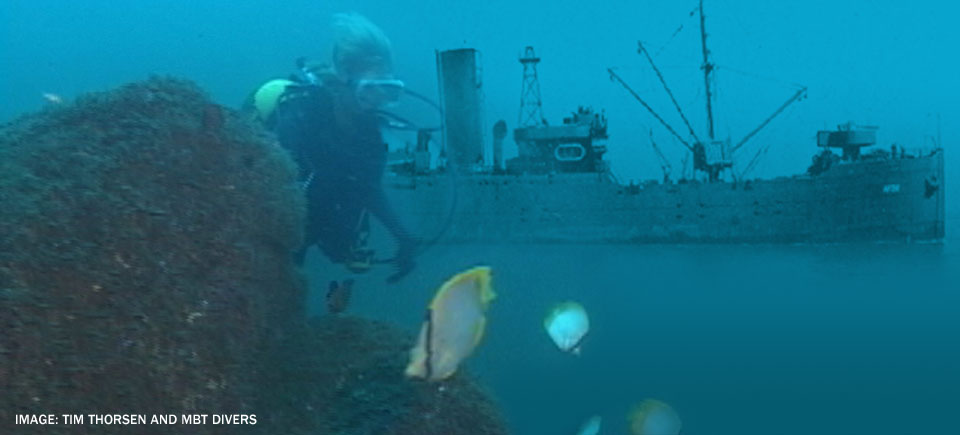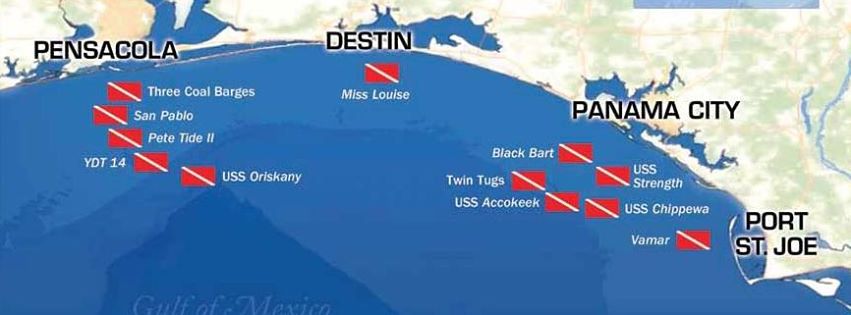News
Dive into history with Florida’s Panhandle Shipwreck Trail

Miles off the Florida Panhandle’s coast rest vessels of history.
The Florida Panhandle Shipwreck Trail is made up of twelve unique shipwrecks, each of which has its own draw and history. The trail was launched in 2012 with the idea of attracting visitors to the Panhandle.
“In order to complete the trail, people would have to travel across the Panhandle,” said Franklin Price, senior archaeologist with the Florida Department of State’s Underwater Archaeology team.
They would also likely have to plan multiple trips to complete the trail, Price said.
The trail was created in part by the archaeology team soliciting dive operators in the area for the shipwrecks that best represented the Panhandle, Price said. Each wreck’s popularity, ecological diversity and history was considered.
For scuba divers, the trail is not to be missed.
“Even if they’re not divers, I hope they still get a better appreciation of the value of what’s down there, of our submerged heritage and the opportunity to explore the shipwrecks and natural reefs,” continued Price.
Passport
Divers who take on the Shipwreck Trail can mark each dive with their “passport.”
Dive masters will sign and place a sticker on the passport after the diver visits each wreck.
Locally, you can get your passport from Emerald Coast Scuba, located at 503 U.S. Highway 98 in Destin, or Scuba Tech, located at the corner of Harbor Boulevard and Marler Street.
The Shipwrecks
Destin:
Miss Louise—A push tugboat that was sunk in 1997. The 95-foot tug lies upright in shallow water about 60 feet down. Storms have flattened some of the top of the tug, said Carla Moore, co-owner of Scuba Tech in Destin. Although it’s close to shore, it can be difficult to reach with fishermen and other dive boats covering the area.
Sea creatures have flocked to the site. Spanish mackerel, kings, barracuda, and baitfish frequent the site. Goliath Groupers, whale sharks, and Manta Rays have also been seen.
“You have to part the fish to see the wreck,” Moore said.
Pensacola:
USS Oriskany — An aircraft carrier that has become a popular diving destination. After serving in the Pacific, The “Mighty O” served in the Pacific before being sunk in 2006. Also nicknamed “The Great Carrier Reef,” the Oriskany is one of the most breathtaking dives, Price said.
YDT-14 — This U.S. Navy dive tender was sunk in 2000. The ship’s upper structure is at 65 feet of depth.
San Pablo — From a historical perspective, this freighter is the most interesting. It once hauled fruit from Central America before being sunk by a U-boat during World War II. It was refloated and was later sunk again in a secret military operation off of Pensacola.
Pete Tide II — This offshore oilfield supply vessel became an artificial reef in 1993. It has three decks of superstructure.
Three Coal Barges —These barges were sunk in 1974. They rest in about 50 feet of water.
Panama City:
Black Bart — A oilfield supply vessel that was sunk in 1977. It sits intact from the top down between 40 and 85 feet of water.
FAMI Tugs — These two tugboats once sat bow to bow, but a storm placed one boat on top of the other.
USS Accokeek — A fleet tugboat that served in both Pacific and Atlantic Oceans. It then became a training vessel for navy salvage divers before being sunk for the last time in 100 feet of water in 2000.
USS Strength — A World War II minesweeper that survived a midget submarine attack and a kamikaze raid.
USS Chippewa — A veteran Navy tugboat now lies upright in 100 feet of water.
Port St. Joe:
Vamar — This ship lies in 25 feet of water. It was a support ship for Admiral Richard Byrd’s 1928 Antarctic expedition, then as a tramp steamer it sank under mysterious circumstances in 1942. Of all the trail’s wreckages, this is the most suitable for snorkelers, but it is still best seen on a dive, Price said.
Shipwreck descriptions courtesy of the Florida Bureau of Archaeological Research.
More details as well as photos and video on each of the trail’s shipwrecks can be found at www.floridapanhandledivetrail.com. Marine forecast and nearby dive shops for each site can also be found.
Source: www.nwfdailynews.com
Main Photo: Tim Thorsen (www.mbtdivers.com)
News
Book Review: Fire on Monroe Bravo by Fred Lockwood

Fire on Monroe Bravo is the latest book in the Jack Collier series by Fred Lockwood. Our story begins with our lead characters, Jack and Sandro, owners of Marine Salvage & Investigation Company, arriving on the Monroe Bravo Oil & Gas Platform in the North Sea. Having secured a contract for their vessel the MV Stavanger to act as support ship to the platform for TransGlobal Oil, our protagonists are on a celebratory visit.
However almost as soon as they arrive a series of explosions rock the platform, causing huge damage, loss of life and the very real danger of a massive human, ecological and financial disaster.

As the danger mounts for both our heroes and the surviving workers, Jack and Sandro will have to escape the inferno, all while trying to save the platform and the men still trapped unable to help themselves.
The disaster sets the scene for the unfolding story lines following the fate of the platform and our main characters, the police investigation into a suspected terrorist act and the actions of TransGlobal Oil as they attempt to navigate the pubic outcry and financial repercussions.
In his eighth book, Fire on Monroe Bravo, Fred Lockwood delivers an explosive thriller, with plenty of above and in-water drama, and our heroes fighting for survival, what more can you ask for?
We thoroughly recommend this read and look forward to the next in the series. For more information about his book series, you can check out the reviews of his previous books here on Scubaverse.
- Title: Fire On Monroe Bravo
- Author: Fred Lockwood
- ISBN: 979-8325324536
Available in a paperback version and for Kindle from Amazon and book stores.
Blogs
Alonissos: The complete diving destination (Part 1)

In June we were incredibly fortunate to be invited to dive in Alonissos, a small Greek Island in the Sporades island chain located in the North Aegean Sea. While I have long been a big fan of the Greek Islands as a great holiday destination, I had not had the opportunity to do any diving on previous visits and Mike and I were extremely excited to see what Alonissos had to offer both above and below the surface!

The Sporades are easily accessible via the airport in Skiathos (the first island in the chain), which is served by Jet2 flights from all major UK airports from May through October. Numerous ferries and charter boats make island hopping from Skiathos Town a breeze. After an hour boat ride, the picturesque port of Patitiri was a wonderful introduction to Alonissos, where we were met by our gracious hosts Kostas of Albedo Travel and Dias of Alonissos Triton Dive Center. Mike and I were delighted to be staying at the Paradise Hotel, aptly named for its stunning views over the sea and great location for walking to the waterfront.

Alonissos is beautifully situated in the National Marine Park of Alonissos and the Northern Sporades, the largest marine protected area in Europe. The surrounding seas offer fabulous marine life, including incredibly rare species such as the Mediterranean monk seal. They boast deep walls covered in gorgonians and sponges, stunning topography with caverns, swimthroughs and pinnacles, and the first accessible ancient shipwreck from 500BC!

In locations where historical sites have been reported, the waters are largely restricted, but with collaboration between government, underwater archeologists and dive centres, incredible underwater museums are being created for a truly unique diving experience. Alonissos is home to the first of these, the Ancient Shipwreck of Peristera Accessible Underwater Archeological Site. The chance to dive into history (along with reports of healthy reef life and amazing underwater topography) meant Mike and I were keen to get in the water.

Our introduction to the diving around Alonissos was at the Agios Georgios Pinnacles, in the channel between Alonissos and Skopelos. This fantastic site was named “The Chimney,’ and proved to have a huge amount to see. We got to a decent depth here (over 25m), and marvelled at a colourful reef wall with a wonderful swim through whose rocky walls were absolutely covered with life. As well as brilliant topography there was no shortage of macro life here. We saw numerous nudibranchs, five different species in total. The second dive at Mourtias reef nearby was a shallower dive along a nice wall with lots of crevices. Several moray eels and grouper called this site home. We enjoyed looking in the crevices for lobster and smaller benthic life, such as cup corals and tunicates.

Our itinerary allowed us two dives a day with afternoons left to explore the island with our hire car and evenings to enjoy the famous Greek hospitality. This proved to be a lovely mix of in-water and land based diversions.

The next days diving to the Gorgonian Gardens and Triton’s Cave was to be even better! These two stunning sites are nothing short of fabulous. The Gorgonian Gardens was a deep wall near to the Agios Georgios islands. The ever-present currents in this deep channel meant that the sea life was amazing … the namesake Gorgonian sea fans dotted the wall at a depth of 30 to 50 meters, getting ever larger the deeper we went. Above 30m was by no means less beautiful, with sponges, corals, scorpionfish, moray eels and some rare and colourful nudibranchs.

The second shallower dive of the day was to Triton’s Cave or the Cavern of Skopelos, on the east side of that island. The spectacular rock formations had wild striations both above and below the water making a truly epic topography. The cavern entrance was at 14m, and big enough for a buddy pair, winding up to 6m and passing two beautiful windows out into the blue. Emerging from the cavern, the light at the shallower depths and the incredible rock formations made for a fantastic gentle swimming safety stop and we all surfaced by the boat with massive grins.

Check out our next blog :Alonissos: The complete diving destination (Part 2)” to hear about our amazing dive on the 2500 year old Peristera Wreck!
Thanks to:
Alonissos Triton Dive Center https://bestdivingingreece.com/
Albedo Travel https://alonissosholidays.com/activities/
Paradise Hotel https://paradise-hotel.gr/
Alonissos Municipality https://alonissos.gr/en/
-

 Blogs2 months ago
Blogs2 months agoDiving With… Nico, Ocean Earth Travels, Indonesia
-

 News1 month ago
News1 month agoMurex Bangka Announce New Oceanfront Cottages & Beachfront Dining
-

 Blogs2 months ago
Blogs2 months agoA new idea in freediving from RAID
-

 Marine Life & Conservation1 month ago
Marine Life & Conservation1 month agoIceland issue millionaire whale hunter a licence to murder 128 vulnerable fin whales
-

 Marine Life & Conservation2 months ago
Marine Life & Conservation2 months agoThe Shark Trust Great Shark Snapshot is back
-

 News3 months ago
News3 months agoCharting New Waters; NovoScuba Goes Global with the Launch of their Revolutionary Dive Training Agency!
-

 Gear News1 month ago
Gear News1 month agoNew Suunto Ocean – a dive computer and GPS sports watch in one for adventures below and above the surface
-

 Marine Life & Conservation Blogs2 months ago
Marine Life & Conservation Blogs2 months agoBook Review: Plankton
















